Once in a while an idea comes to you that is so perfect in its elegance, so suited for time, place and people, and so darn delicious that everyone wants to take credit for it. Such was Pizzapalooza, my very own brainchild. My idea that we take our final few days in Italy after the conclusion of our Cucinapalooza cooks tour and spend them in Naples in search of the perfect pizza napoletana. This is the story of our pizza odyssey, which Suzy, Pete and Nancy can all agree – was my idea.
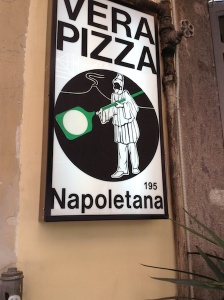 After six days of intense cooking in Umbria, working alongside of some of the most beloved chefs from Perugia to Montefalco, we were ready for a change of pace. Just not a huge change of pace. Pizzapalooza was just that diversion and during our two and a half days together (plus an extra day of just Suzy and me), our group of four forged from pizzeria to pizzeria like modern day Pacmen, straying only occasionally from our culinary itinerary to sup on a bit of Naples’ history (such as our visit to the Archeological Museum and a walking tour of Naples), to give a little cultural balance to our carboloading. But the focus of our brief visit to the capital of southern Italy, the birthplace and pretty much the undisputed home of pizza was unmistakable – to consume as much gooey, doughy goodness as our consciences and belts would allow.
After six days of intense cooking in Umbria, working alongside of some of the most beloved chefs from Perugia to Montefalco, we were ready for a change of pace. Just not a huge change of pace. Pizzapalooza was just that diversion and during our two and a half days together (plus an extra day of just Suzy and me), our group of four forged from pizzeria to pizzeria like modern day Pacmen, straying only occasionally from our culinary itinerary to sup on a bit of Naples’ history (such as our visit to the Archeological Museum and a walking tour of Naples), to give a little cultural balance to our carboloading. But the focus of our brief visit to the capital of southern Italy, the birthplace and pretty much the undisputed home of pizza was unmistakable – to consume as much gooey, doughy goodness as our consciences and belts would allow.
And we did a pretty good job of it. Over the course of five non-breakfast meals we tucked in at eight different pizza establishments, downing upward of 20 pizzas. Throw in the two preliminary rounds we undertook in Ischia the days before our arrival in Naples and one final last gasp (literally) by Suzy and me after Pete and Nancy’s departure and you can see why by the end of this all we were channeling the classic Alka Seltzer commercials of the 1970s. “I can’t believe I ate the whole thing.”
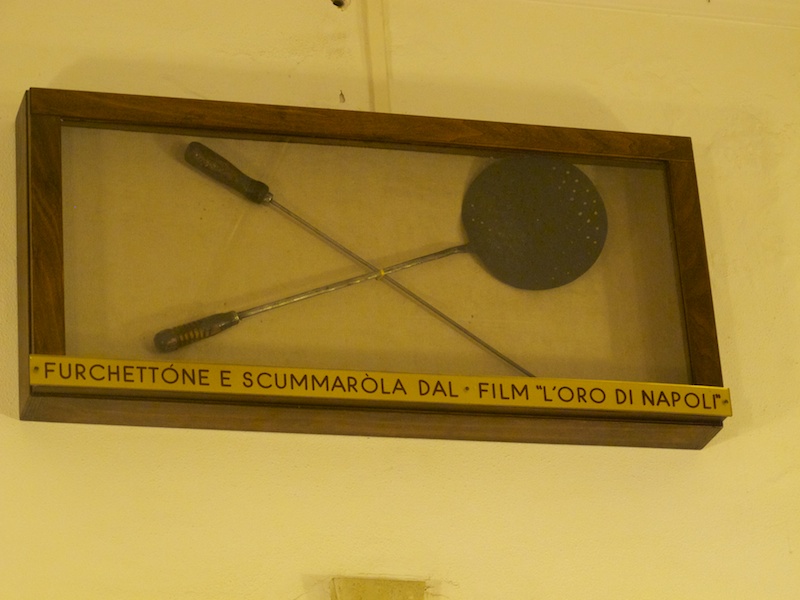
But all this falderal about pizza was much more than just folly. We had prepared for our excursion with laser guided precision, having researched the most revered and historic shrines to the pizza gods, plotting them out on a map to ensure we could fit them all in (even if they did not all fit in us). And we developed a scientific rating process to ensure consistency of our reactions and abject fairness as we compared and critiqued those who have devoted their lives to making the masses happy, one pie at a time.
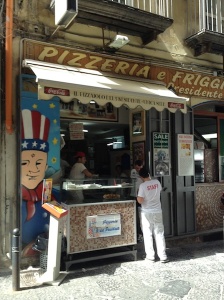 Our rules called for us to try two or three pizzas at every establishment, a guideline we mostly adhered to until the excessive cheese intake began to clog our arteries, as well as in cases where we were downing a pizza in piedi – standing on the sidewalk outside the pizzeria when we were sampling from one of Naples’ numerous pizza stands. In those cases, the act of dividing our pizza into four by hand-tearing it and trying to down the semiliquid, fully gooey mess into our mouths, often without a safety net of napkins, without spilling the molten cheese portion onto exposed skin, clothing or the ground, argued for us to limit our efforts to just one pizza. But in the many upscale ristorante-pizzerias or even the simple indoor pizzerias we frequented, we tended to order the full Monty which our rules called for. In those cases we ordered the standard required under our disciplinario – the classic pizza margherita – along with whatever was deemed to be the house specialty (which often carried the name of the restaurant or was recommended by the waiter as one of their best) and, in the best cases a third that appealed to our panel of expert judges. The actual best cases were when we threw caution to the winds and ordered una per ognuno – one for each of us which, if you can do the math, meant ordering four different circles of doughy deliciousness.
Our rules called for us to try two or three pizzas at every establishment, a guideline we mostly adhered to until the excessive cheese intake began to clog our arteries, as well as in cases where we were downing a pizza in piedi – standing on the sidewalk outside the pizzeria when we were sampling from one of Naples’ numerous pizza stands. In those cases, the act of dividing our pizza into four by hand-tearing it and trying to down the semiliquid, fully gooey mess into our mouths, often without a safety net of napkins, without spilling the molten cheese portion onto exposed skin, clothing or the ground, argued for us to limit our efforts to just one pizza. But in the many upscale ristorante-pizzerias or even the simple indoor pizzerias we frequented, we tended to order the full Monty which our rules called for. In those cases we ordered the standard required under our disciplinario – the classic pizza margherita – along with whatever was deemed to be the house specialty (which often carried the name of the restaurant or was recommended by the waiter as one of their best) and, in the best cases a third that appealed to our panel of expert judges. The actual best cases were when we threw caution to the winds and ordered una per ognuno – one for each of us which, if you can do the math, meant ordering four different circles of doughy deliciousness.
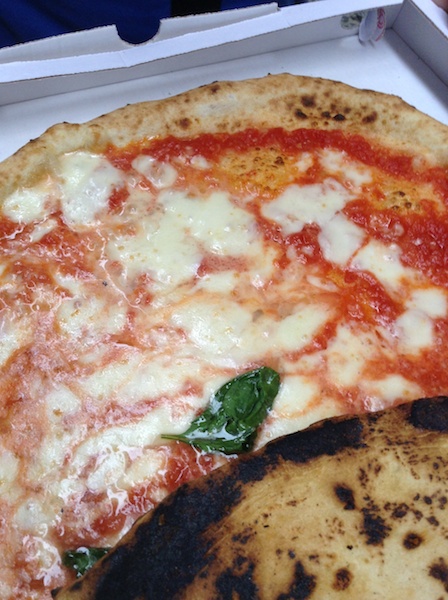 The margherita was the common pizza-shaped thread that tied each of our subject establishments together and provided a consistent baseline for judging them. And margherita was chosen for good reason, not just because it is usually the first item to appear on the menu. For the Neapolitan or Napoletano, pizza margherita is pizza. This cunningly plain pizza with just four elements (dough, tomato, mozzarella and basil) is anything but plain. And expressed in those four simple but simply delicious elements is the essence of pizzaness itself which speaks to all the senses – touch, smell, sight, taste and, yes sound. Well not so much sound unless you count the food noises made by your fellow diners after tasting this classic meal. In the pizza margherita, which is so fundamental to la vera pizza napoletana, one finds the true meaning of pizza. And for this reason the association of pizzaioli napoletani has even created a certification system for pizza margherita, which governs the precise ingredients used, the requirement of hand stretching the dough and which limits the cooktime of the pizza in a woodburning oven to no more than one minute. In addition to making millions of Naples residents and visitors happy, the Associazione Verace Pizza Napoletana has made the Italian firewood association very happy as well.
The margherita was the common pizza-shaped thread that tied each of our subject establishments together and provided a consistent baseline for judging them. And margherita was chosen for good reason, not just because it is usually the first item to appear on the menu. For the Neapolitan or Napoletano, pizza margherita is pizza. This cunningly plain pizza with just four elements (dough, tomato, mozzarella and basil) is anything but plain. And expressed in those four simple but simply delicious elements is the essence of pizzaness itself which speaks to all the senses – touch, smell, sight, taste and, yes sound. Well not so much sound unless you count the food noises made by your fellow diners after tasting this classic meal. In the pizza margherita, which is so fundamental to la vera pizza napoletana, one finds the true meaning of pizza. And for this reason the association of pizzaioli napoletani has even created a certification system for pizza margherita, which governs the precise ingredients used, the requirement of hand stretching the dough and which limits the cooktime of the pizza in a woodburning oven to no more than one minute. In addition to making millions of Naples residents and visitors happy, the Associazione Verace Pizza Napoletana has made the Italian firewood association very happy as well.
And while the margherita served the purpose of establishing a consistent baseline for comparing each of our contestants, it also served the purpose of educating our palate as to what constitutes a truly great pizza. And in our nine contestants we did find some truly great pizzas, simple, humble unadorned pizze margherite, ones that made you sit upright, shake your head in disbelief and order another.
But our rating system did not rely solely on the margherita. Just as man does not live on 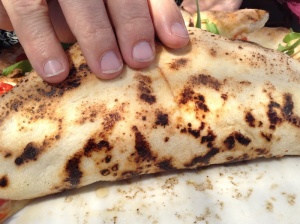 bread alone, our rating system depended not just on margherita but also on its bready base, the crust. For each of our assessments looked carefully at the restaurant’s ability to make a memorable crust, not just on the margherita but across all the pizzas we were to try. Pizza crust, la crosta, like most foods in Italy, responds heavily to regional influences. The same sensibilities that cause a Roman, who likes his porchetta from Ariccia, to scoff at the Marchigiana variety, give rise (no pun intended) to much crust snobbery across the regions. In our native Umbria the distinct preference is for a thinner crust and one that is firmer and approaching crackery, with a bit of crunch when it is cut and chewed. Such is not the case with Naples pizza, where a more doughy, chewy crust – but one with a certain chewy and dare I say crunchy mouthfeel – is de rigeur. And in Naples we consistently found that puffier volumetric crust, a puffiness that doesn’t approach the wonderbread quality of American pizzas like Dominoes, but whose greater volume and voluptuousness appeals to the southern palate more than the crackery goodness that appeals to our Umbrian paesan. On this one, I think our group were all Neapolitans.
bread alone, our rating system depended not just on margherita but also on its bready base, the crust. For each of our assessments looked carefully at the restaurant’s ability to make a memorable crust, not just on the margherita but across all the pizzas we were to try. Pizza crust, la crosta, like most foods in Italy, responds heavily to regional influences. The same sensibilities that cause a Roman, who likes his porchetta from Ariccia, to scoff at the Marchigiana variety, give rise (no pun intended) to much crust snobbery across the regions. In our native Umbria the distinct preference is for a thinner crust and one that is firmer and approaching crackery, with a bit of crunch when it is cut and chewed. Such is not the case with Naples pizza, where a more doughy, chewy crust – but one with a certain chewy and dare I say crunchy mouthfeel – is de rigeur. And in Naples we consistently found that puffier volumetric crust, a puffiness that doesn’t approach the wonderbread quality of American pizzas like Dominoes, but whose greater volume and voluptuousness appeals to the southern palate more than the crackery goodness that appeals to our Umbrian paesan. On this one, I think our group were all Neapolitans.
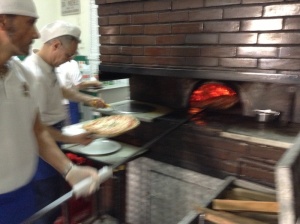 But as we were to learn, dough is not sufficient to guarantee an upper crust crust. Much depends upon the cooking, which in Naples is done always in a woodburning oven, at a temperature high enough to melt glass, upwards of 1000 degrees (F). In these superhot ovens, the pizza doesn’t have a chance and under the rules of the local pizza consortium, a sort of cosa nostra of pizza, cooktime cannot exceed one minute. Pete and I dutifully stood around a number of ovens at the restaurants we visited and can verify obedience to this rule. From the time the pizzaiolo shoveled the raw pie into the domed shaped oven to the time it emerged fully cooked, was on average around 50-55 seconds. Interestingly, too, in the final seconds of cooking, the pizzaiolo typically lifts the pizza from the oven floor with his paddle and waves it through the air toward the hotter top of the domed oven, presumably to give a final melting and fusing of the ingredients and to encourage a bit more char on the crust.
But as we were to learn, dough is not sufficient to guarantee an upper crust crust. Much depends upon the cooking, which in Naples is done always in a woodburning oven, at a temperature high enough to melt glass, upwards of 1000 degrees (F). In these superhot ovens, the pizza doesn’t have a chance and under the rules of the local pizza consortium, a sort of cosa nostra of pizza, cooktime cannot exceed one minute. Pete and I dutifully stood around a number of ovens at the restaurants we visited and can verify obedience to this rule. From the time the pizzaiolo shoveled the raw pie into the domed shaped oven to the time it emerged fully cooked, was on average around 50-55 seconds. Interestingly, too, in the final seconds of cooking, the pizzaiolo typically lifts the pizza from the oven floor with his paddle and waves it through the air toward the hotter top of the domed oven, presumably to give a final melting and fusing of the ingredients and to encourage a bit more char on the crust.
The intense heat of these ovens tends to cause large blisters of crust to rise and those 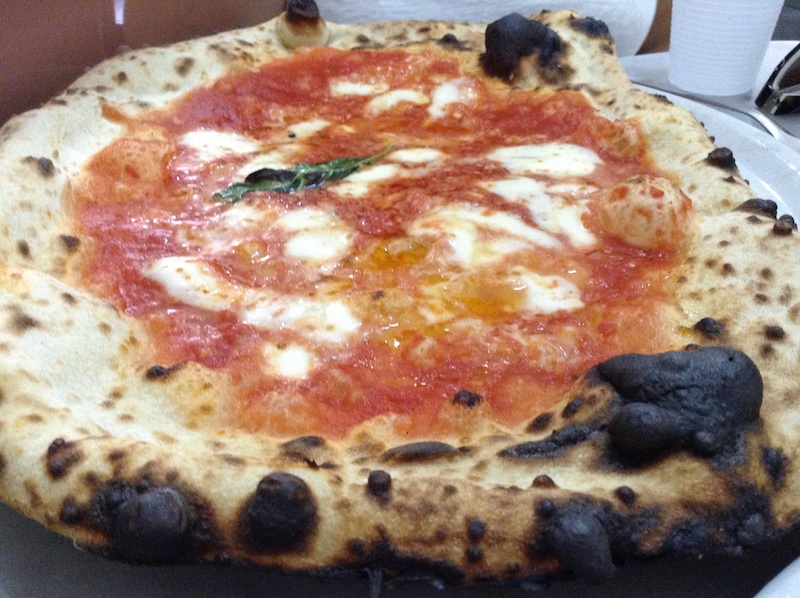 thinner pieces as well as portions of the edge and bottom will char, intensifying the flavor of the crust and even bringing out the flavors on top of the pizza. If you doubt me, next time you try a simple bruschetta topped with fresh olive oil try burning or scorching a corner or two of your bread (this is easily done if toasting your bread on a grill) and compare the final product with a lightly toasted sample. You will immediately taste a much greater intensity in the olive oil on the scalded bread. (Sprinkle a few flakes of sea salt to pump up the volume to a shattering roar of deliciousness).
thinner pieces as well as portions of the edge and bottom will char, intensifying the flavor of the crust and even bringing out the flavors on top of the pizza. If you doubt me, next time you try a simple bruschetta topped with fresh olive oil try burning or scorching a corner or two of your bread (this is easily done if toasting your bread on a grill) and compare the final product with a lightly toasted sample. You will immediately taste a much greater intensity in the olive oil on the scalded bread. (Sprinkle a few flakes of sea salt to pump up the volume to a shattering roar of deliciousness).
Finally, a word about ingredients and toppings. Eschew the Ragu®. Naples pizza uses tomatoes, not tomato sauce, with some establishments adorning their pizzas with a minimalist topping of sliced filets of San Marzano tomatoes (which have fewer seeds and less acidity than other varieties) that results in a thin, runny sauce that transforms the crust into a gooey puddle of breadiness (in a good way). Others create a rich, thicker tomato sauce that similarly bathes the crust but which stands out as its own independent taste center. Hams, porchetta, cheeses – we tried the gamut and while our opinions were mostly consistent with one another, as with most things, beauty, or in this case, the perfect pizza, is in the eye of the beholder.

As Dino Martini (Dean Martin) is fond of saying “When the moon hits your eye like a big pizza pie, that’s amore.” We found amore and lotsa more in Naples.
And now for our judges’ opinions:
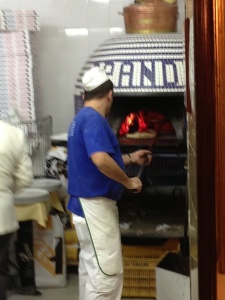 Pizzeria Brandi.
Pizzeria Brandi.
Ratings – 7.125 (crust), 8 (marg.), 8 (favorite) – 7.71 overall
Just a short walk from our hotel, Pizzeria Brandi was not our first choice for our first dinner and first pizza in Naples, but not due to any deficiency of its own. Instead we had planned to dine at the closer Europeo di Mattozzi after our late arrival on Sunday night. What we hadn’t prepared for was for Mattozzi to be closed on Sunday. So right out of the gates we had to improvise. We’re glad we did.
Legend has it, as does the large plaque on the wall, that pizza margherita was invented by the forerunners of Brandi and so it was more than appropriate that the starting line of our marathon to Tastyville began at Brandi. And although we had little to compare Brandi’s 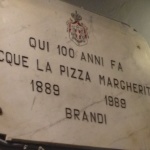 offerings to, we knew that theirs was a very good -although, we hoped, not the best – pizza we would be tasting over the next couple of days.
offerings to, we knew that theirs was a very good -although, we hoped, not the best – pizza we would be tasting over the next couple of days.
Our menu consisted of a margherita, a pizza bianca (no tomato sauce) with sausage, broccoli rabe and cheese, and a pizza with anchovy, capers and olives. And our judges looked favorably on all three, with the margherita chosen as the favorite by all four panelists. Good char led to a crust rating of 7.125 (out of 10), with the margherita garnering 8 points and our “favorite” category (rating each judge’s favorite pizza) also awarded 8 points. The sitdown restaurant will appeal equally to those who don’t want pizza, and features good service, a nice (and historic) atmosphere and a good wine list.
 Our bill, for the 3 pizzas, 2 salads, 2 beers and 1 bottle of wine came out to €74 euros (excluding gratuity).
Our bill, for the 3 pizzas, 2 salads, 2 beers and 1 bottle of wine came out to €74 euros (excluding gratuity).
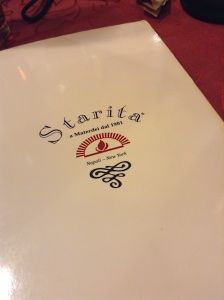 Starita Pizzeria Napoletana.
Starita Pizzeria Napoletana.
Ratings – 8 (crust), 8 (marg.), 8.75 (favorite) – 8.25 overall
After working up a powerful hunger visiting the national Archeological Museum, our one cultural activity for our first full day in Naples, we eagerly headed to Starita, an acclaimed pizzeria on via Materdei to get down to the real business of our visit. And Starita did not disappoint.
The restaurant is not much more than a hole in the wall, with simple tables and a few booths. But the walls are lined with all manner of memorabilia from l’Oro di Napoli, a famous Italian movie that featured Sofia Loren as a pizziaola making pizza right there in Starita. Sofia looks awfully good with a bit of flour on her face and clothing. We’ll skip all the jokes about dough kneading that ensued.
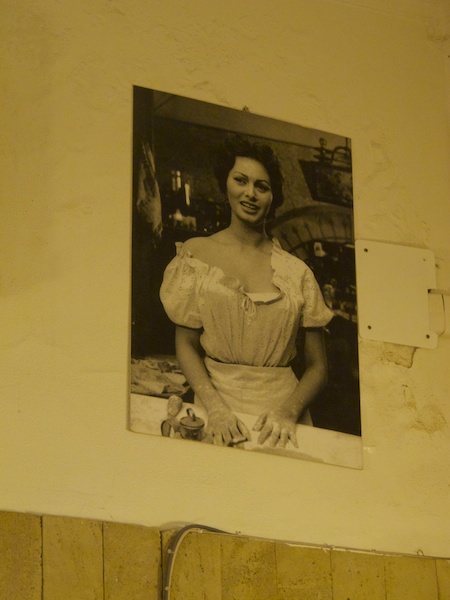
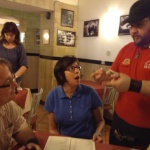 But we were not going to let a couple dozen photos of a dazzling Sofia Loren interfere with or distract us from our enjoyment of pizza and boy, was our focus well rewarded. This being the first meal of our first full day in Naples we went whole hog. Literally. In addition to the obligatory margherita (this one with mozzarella di bufala), the house specialty Montanara (a pan fried dough that is topped with a pre baked tomato sauce and provola and pecorino romano cheeses that gives it a smoky taste) we added a pizza topped with porchetta from Ariccia, a town in the Castelli Romani hills just outside of Rome known throughout Italy for its roasted whole hog. Talk about hog heaven. Not satisfied with just three pies, after polishing them off we ordered a “dessert” of a San Marzano pizza, a sweeter margherita type pie that was literally swimming in liquid (in a good way). It was an orgy of eating.
But we were not going to let a couple dozen photos of a dazzling Sofia Loren interfere with or distract us from our enjoyment of pizza and boy, was our focus well rewarded. This being the first meal of our first full day in Naples we went whole hog. Literally. In addition to the obligatory margherita (this one with mozzarella di bufala), the house specialty Montanara (a pan fried dough that is topped with a pre baked tomato sauce and provola and pecorino romano cheeses that gives it a smoky taste) we added a pizza topped with porchetta from Ariccia, a town in the Castelli Romani hills just outside of Rome known throughout Italy for its roasted whole hog. Talk about hog heaven. Not satisfied with just three pies, after polishing them off we ordered a “dessert” of a San Marzano pizza, a sweeter margherita type pie that was literally swimming in liquid (in a good way). It was an orgy of eating.
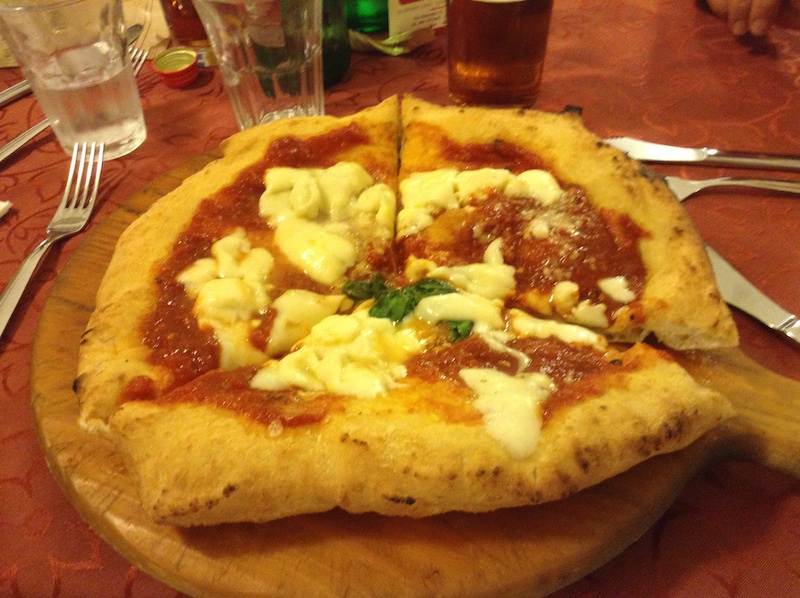
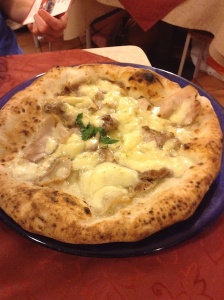
Our group could not get enough of Starita. Pete liked the cooked ragu on the fried Montanara dough, with Suzy noting the sweet chunks of San Marzano tomatoes on the margherita. And while none of the pizzas individually were heads and tails above those of Brandi, the general consensus was the Starita had an incredibly deep bench, a stronger cast of supporting characters than our first stop. Whereas Brandi’s margherita was head and shoulders better than their other pizzas, each of Starita’s was a joy in itself and covered an incredible range of tastes – margherita and San Marzano occupying the simpler, purer niche, with the porchetta getting the nod for fulsomeness and the Montanara being the draw that would bring you back for something you couldn’t find anywhere else. Top that off with a historic venue and a terrific, garrulous waiter who not just served up pizza but heaping ladlesful of pizza wisdom and you have all the ingredients for a memorable lunch. Starita 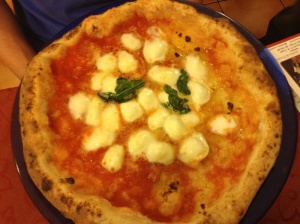 is definitely worth a return visit many times over and, as we were excited to learn from the menu and our waiter, can now be visited closer to home. The owners have opened a New York City branch called Don Antonio di Starita. We’re excited to give it a try and will report back soon.
is definitely worth a return visit many times over and, as we were excited to learn from the menu and our waiter, can now be visited closer to home. The owners have opened a New York City branch called Don Antonio di Starita. We’re excited to give it a try and will report back soon.
Four pizzas, 6 draught beers (plus one bottled), 2 coffees and a limoncello totaled €72.
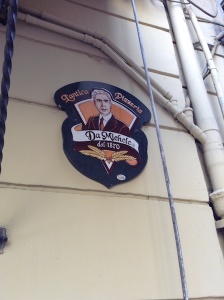 Da Michele.
Da Michele.
Ratings – 7.75 (crust), 8.25 (marg.), 8.25 (favorite) – 8.08 overall
Da Michele is a, if not the, institution in Naples. It routinely boasts of waits of an hour or more for a table and so when we arrived there directly from our lunch at Starita (at a little after 4:oopm) and were ushered directly to a table we knew the pizza gods (I believe one of them is named Pan) were looking down on us kindly.
We arrived at da Michele with great anticipation as its reputation had greatly preceded it. And true to form we ordered our standard – the margherita – this time adding only a pizza marinara (tomato, garlic and oregano) to our order due to the fact that four Starita pies were already occupying the space that additional da Michele pies otherwise would. We were quickly learning the Law of Conservation of Mass and Energy. Studying pizza is such an interdisciplinary joy.

And although da Michele did not disappoint it did not wow either. As reflected in the ratings, the pizza here was fabulous, the crust being a little thinner and the pizzas slightly larger than our previous offerings. But they were no better than Starita (and only marginally better than Brandi), although Pete felt the marinara was among the best pizza he had ever eaten. The setting was a bit of a minus as well, a bit drab with tile walls and perfunctory service. Nonetheless we would come back here for the pizza, which is clearly (and appropriately) the main draw for this pizzeria.
Our meal of 2 pizzas and 2 bottles of water came out to an unbelievable €12.50, perhaps another draw of this beloved eatery.
Ristorante Europeo di Mattozzi.
Ratings – 8 (crust), 7.75 (marg.), 8 (favorite) – 7.92 overall
Dinner our second night was at the nearby Europeo di Mattozzi restaurant, which had been closed on Sunday night. We sat down at a late hour, having given the Starita and da Michele pizzas a bit of time to digest. We were now beginning to hit our stride.
Dinner at Europeo was just that, dinner. We ordered two pizzas – the obligatory margherita and a chef’s special with tomatoes and tomato sauce topped with mushrooms, cured pancetta, mozzarella and basil, which was all four of our group’s favorite. But in addition, we ordered two platters of fried fishes, the typical mixed plate that includes piles of tiny fished that resemble guppies frozen in Carbonite, larger fish battered and with head and tail still extant and rings of calamari and different types of shrimps. We distinguished Europeo from our earlier pizzagorging by considering this a restaurant with pizza rather than a pizzeria per se. That being said, the pizza was excellent, too, but this is a good choice for dinner, where pizza can play an important role but one role among many.
The service at Europeo was excellent, as attested to by our contentment and the fact that it was crowded with locals, well dressed, with big appetites and clearly enjoying themselves. In addition to the pizza and fritto misto, we had a plate of hauntingly bitter greens and a delightful salad, bringing just a bit of balance to our carb heavy diet. The wine list was outstanding as well.
Back to the pizzas, we all thought the crust was top tier, perhaps not quite as charred as others but with a perfect balance of saltiness. The mozzarella on the margherita was top shelf but it oddly the pizza itself may have suffered from an overload of basil. The chef’s special, with its pile of mushrooms, generous portion of pancetta and tasty mozzarella was our group’s favorite and vied with Starita’s Montanara as the favorite specialty pizza to date. Visually it was stunningly beautiful. Almost too beautiful to eat. But we forced ourselves to, anyway.
Dinner at Europeo, which consisted of the two pizzas, two platters of fritto misto, the two side dishes, 4 bottles of water, a bottle of white and bottle of red (apologies to Billy Joel) and three coffees came out to €152.
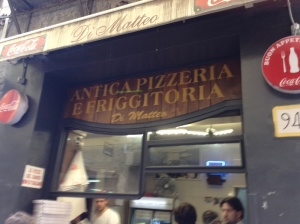 Pizzeria di Matteo.
Pizzeria di Matteo.
Ratings – 6.75 (crust), 7 (marg.), 7.25 (favorite) – 7 overall
The morning of our second full day in Naples (and Pete and Nancy’s final day) was taken up with a four hour workout under the guise of a walking tour. And when our tour guide Giuseppe left us off near the Duomo of Naples our thoughts turned quickly to pizza. Enough culture, it’s time to eat.
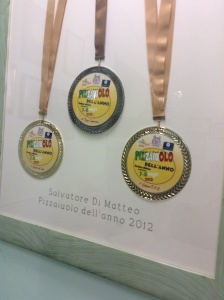
Our first of three afternoon stops was at Matteo, which appears from the street to be a simple pizza stand with a counter where pies are served to passers by. It is also one of the three (or more) pizzerias that claims to have been patronized by President Clinton, who just as George Washington appears to have slept everywhere, seems to have eaten pizza at just about every eatery in this pizza crazy town. Given Bubba’s well known appetites, it may not be too far from the truth.
We opted against street pizza and went inside Matteo, up a narrow staircase and through a couple of cramped dining rooms until we reached our table. The atmosphere was less than pleasant with service to match. And, unfortunately, the pizza did not make up for these deficiencies.
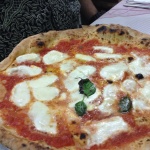 We ordered three pizzas at Matteo, a margherita, a fried pizza with sausage and the same bitter greens we had enjoyed at dinner the previous evening at Europeo and a house specialty stuffed pizza called the World Cup, which was filled with ricotta and fatty ham. And while the margherita was the unanimous favorite of the group, it did not particularly stand out or distinguish itself among its peers. The crust was so so, with some good chew but lacking any of the desirable crunch we were coming to expect. It had some, but not much char and like the restaurant in general, lacked volume. Our collective assessment of the margherita (which again was our group’s favorite) was “meh.”
We ordered three pizzas at Matteo, a margherita, a fried pizza with sausage and the same bitter greens we had enjoyed at dinner the previous evening at Europeo and a house specialty stuffed pizza called the World Cup, which was filled with ricotta and fatty ham. And while the margherita was the unanimous favorite of the group, it did not particularly stand out or distinguish itself among its peers. The crust was so so, with some good chew but lacking any of the desirable crunch we were coming to expect. It had some, but not much char and like the restaurant in general, lacked volume. Our collective assessment of the margherita (which again was our group’s favorite) was “meh.”
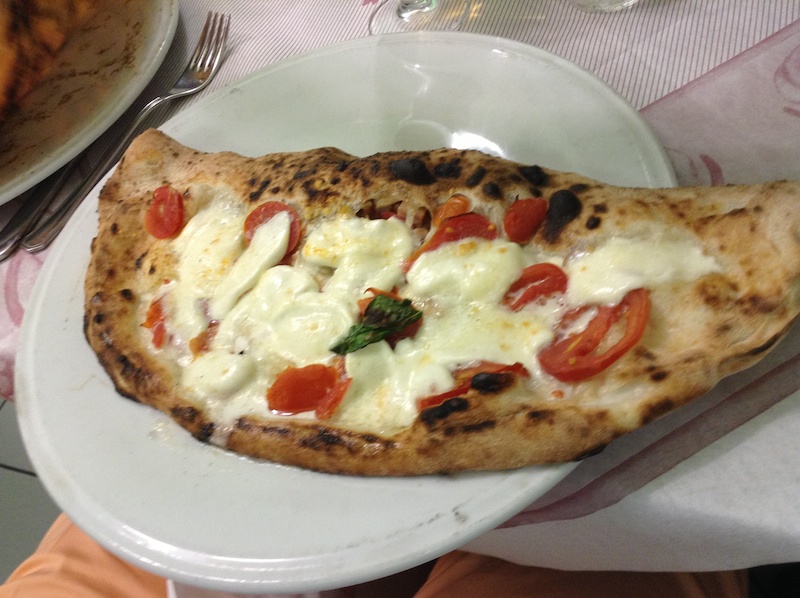
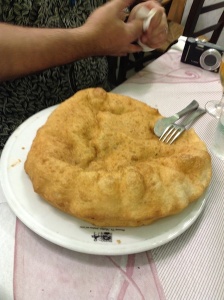
The fried pizza was a terrible disappointment, particularly when compared to Starita’s fried Montanara. This was a stuffed, rather than open pizza, which was fried (Starita fried its dough then topped it and baked the whole affair), filled with a rather tasty sausage and bitter greens. But the dough was tired and without much taste. The World Cup had flashes of potential, but I found the ricotta, a blander cheese than mozzarella, to be an odd taste. In this case the World Cup fell far short of its gooooooooooooooooooooal.
Lunch at Pizzeria di Matteo, consisting of the three pizzas, four large beers and four small waters cost €34.
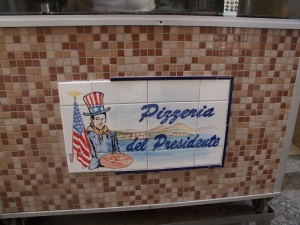
Pizzeria e Friggitoria del Presidente.
Ratings – 7.25 (crust), 7.75 (marg), n/a (favorite) – 7.5 overall
Just down the street from di Matteo is another supposed Clintonian haunt, the aptly (if perhaps fictitiously) named Pizzeria del Presidente. And if our 42nd president was a stand up guy then it is appropriate that this establishment is a stand up pizzeria. Here you order and pay for your pizza at a counter opening on to the street and find a wall to lean against and enjoy your pizza. After visiting five pizzerias, we were getting good at leaning against walls.
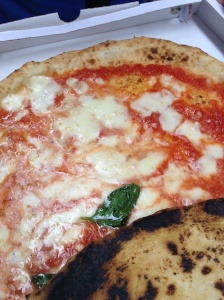 It’s a little difficult to compare this type of offering with those of its sitdown and restaurant brethren, but the stand up (or take away) format does seem to work and has its place in the pizza pantheon. Here, though, we did learn some simple rules for eating at a standup pizzeria. Gravity is not your friend. Get plenty of napkins and if possible, have the pizzaiolo cut it into slices for you. Tearing chewy Neapolitan crust by hand is a messy and ultimately losing battle. On the plus side, you get to lick your fingers when you have finished separating it.
It’s a little difficult to compare this type of offering with those of its sitdown and restaurant brethren, but the stand up (or take away) format does seem to work and has its place in the pizza pantheon. Here, though, we did learn some simple rules for eating at a standup pizzeria. Gravity is not your friend. Get plenty of napkins and if possible, have the pizzaiolo cut it into slices for you. Tearing chewy Neapolitan crust by hand is a messy and ultimately losing battle. On the plus side, you get to lick your fingers when you have finished separating it.
Presidente’s pizza was good but not great. I would rate it somewhere between a Millard Filmore or James Buchanan and Woodrow Wilson. This pizza will definitely never make it to Mount Rushmore, but if I were in the neighborhood I would definitely rush there for more. The crust was above average but a bit soggy with good tomato sauce and mozzarella.
You can’t beat the price, though. Our one pizza margherita cost €3, a price that appeals to deficit hawks and Keynesians alike.
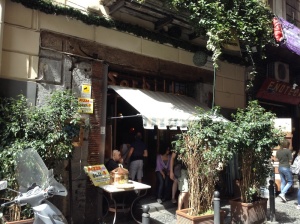 Pizzeria Sorbillo.
Pizzeria Sorbillo.
Ratings – 7.75 (crust), 7.75 (margherita), n/a (favorite) – 7.75 overall
Another street offering, Pizzeria Sorbillo is near Presidente and di Matteo. In fairness, the pizzeria has a very nice looking dining room and appears to be a real hot spot – perhaps reaching the level of local institution – offering specials to locals and offering its own pizza academy. However, after lunch and a snack pizza we were not much interested in sitting down and surveying Sorbillo’s offerings. Instead we opted for the eat and run, stand up on the street corner. The same rules apply to Sorbillo as Presidente – having them cut your pizza into slices generally means you are going to eat more of what you have paid for.
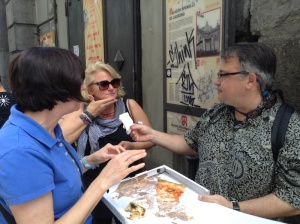
The Sorbillo stand up offering was exceptionally good. The crust was perhaps a bit thinner than some others we had tried, but it had exceptional chew and good char. The tomato sauce was extremely well balanced and it was served piping hot.
At €3.50 it was slightly more expensive than Pizzeria del Presidente but worth every extra eurocent. This was a tantalizingly good pizza that made it onto our return visit list. We would like to go back for a sit down and take their complete menu out for a test drive.
 Ristorante da Ettore.
Ristorante da Ettore.
Ratings – 8.25 (crust), 8.38 (marg.), 8.5 (favorite) – 8.38 overall
Da Ettore (Hector’s), while on our target list, made it as our final night’s dinner restaurant largely due to the strong recommendation of our morning tour guide Giuseppe, who happens to be a good friend of Ettore. In fact, Giuseppe called the restaurant for us to make our late night reservation, which may account for the fabulous outdoor table we were seated at on a wide sidewalk in a quiet neighborhood in Naples. Giuseppe could not take credit, however, for the perfect cool weather, an appearance by our friend and colleague Wendy and her best friend, or the wonderful outdoor music. Combined, these elements made for a special and memorable evening, and that was even before the food was served.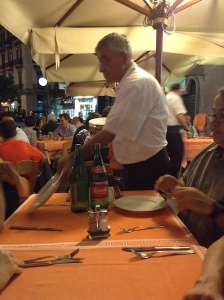
Dinner at da Ettore included two pizzas but also included the obligatory fried fish plates and other non-pizza dishes, including a soute di vongole (sautéed clams), all of which were outstanding and served with a bit of attitude (for show) by Ettore, who at first pretended to not like us but who warmed up to us as our compliments continued to gush like water from a fire hydrant. And as for Ettore’s pizza? Put simply, the pizza at this restaurant/pizzeria, was as good as any we ate in Naples.
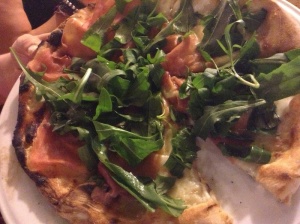 We ordered two pizzas here, our usual (the margherita) and a pizza campagnola, an offering with fior di latte mozzarella cheese and topped with prosciutto and arucola. Our four regular judges rated the margherita as the favorite, with newcomer Wendy selecting the campagnola. Our group rated Ettore’s margherita as one of the best we had tasted, with a superb crust – chewy, crunch and smoky-char. The margherita was topped with an outstanding mozzarella di bufala that partially melted, echoing the crust with a bit of softness tinged with occasionally chewiness. The overall balance of ingredients and flavors was outstanding.
We ordered two pizzas here, our usual (the margherita) and a pizza campagnola, an offering with fior di latte mozzarella cheese and topped with prosciutto and arucola. Our four regular judges rated the margherita as the favorite, with newcomer Wendy selecting the campagnola. Our group rated Ettore’s margherita as one of the best we had tasted, with a superb crust – chewy, crunch and smoky-char. The margherita was topped with an outstanding mozzarella di bufala that partially melted, echoing the crust with a bit of softness tinged with occasionally chewiness. The overall balance of ingredients and flavors was outstanding.
For a great pizza and an even better overall evening, head to da Ettore. The margherita cost €9 (in our exuberance we didn’t note the price of the campagnola or the overall meal cost) and was worth every penny.
* * *
With the departure of Pete and Nancy the following morning, Suzy and I proclaimed ourselves officially through with pizza. On a day when our thoughts turned to packing and returning home after nearly two weeks of nonstop of cooking and eating, a span that started with a couple magical days in a 14th century castle tower and a couple of private dinners in our hotel-castle’s armory, a week leading and participating in an intensive hands-on cooking course that culminated with our group preparing dinner for an assemblage of 30 mostly Italians, our first visit to the enchanting island of Ischia and now this, two and a half days on the trail of Naples’ best pizza, a culminating meal was not at the forefront of our minds. After all of this you can forgive me if I say that we were a bit pie eyed when it came to the idea of more pie. Nonetheless, after spending the morning packing up and catching up on business into the early hours of the afternoon we decided to wander the streets of Naples to see if we could find and adventure. And perhaps just a bite to eat.
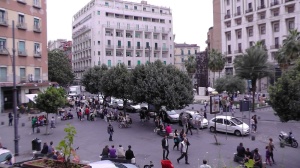
That day happened to be Labor Day in Italy, and when we emerged from the Romeo in the middle of the afternoon, we emerged into a completely different Naples than the one we had experienced the days before. The usual roar and buzz of traffic had been replaced by the slow soft shuffling of thousands if not tens or hundreds of thousands of Neapolitans wandering the streets, pushing strollers and enjoying their day off. It was an eerie feeling to see Naples moving so slowly, but a welcome one. And so we wandered, too, enjoying the calm but also growing hungrier by the minute and unable to find an open eatery that gave any hint of serving halfway decent food.
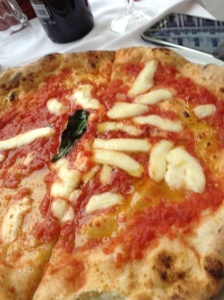 Then after about an hour and a half of wandering we came across the Pizzeria di Mattozzi, a centrally located pizzeria run by the same family that runs the ristorante Europeo. We entered the nearly empty Mattozzi and eventually found a waiter, and obtained his permission to seat ourselves at one of the many outdoor tables, nearly all of which were, strangely, empty on this holiday day. Sitting in a piazza overlooking the main thoroughfare Via Toledo, our outdoor table was perfect for watching the Neapolitan holidaymakers pass by. We ordered a margherita, for old times sake, and took in the sights and sounds. A while later, when our food arrived, we agreed that neither the pizza nor the service was particularly up to the standards that had been set earlier in the week, perhaps due to a wee bit of resentment among the pizzaiolo and the waiter that they had been singled out, among millions of Neopolitans to be the only two who had to work on Labor Day. Our margherita was seriously undercooked, with the cheese not melting and the flavors not fusing into one another as they do here. And the crust, barely dappled with char, belied the fact that perhaps the oven was not up to temperature on this lazy holiday afternoon.
Then after about an hour and a half of wandering we came across the Pizzeria di Mattozzi, a centrally located pizzeria run by the same family that runs the ristorante Europeo. We entered the nearly empty Mattozzi and eventually found a waiter, and obtained his permission to seat ourselves at one of the many outdoor tables, nearly all of which were, strangely, empty on this holiday day. Sitting in a piazza overlooking the main thoroughfare Via Toledo, our outdoor table was perfect for watching the Neapolitan holidaymakers pass by. We ordered a margherita, for old times sake, and took in the sights and sounds. A while later, when our food arrived, we agreed that neither the pizza nor the service was particularly up to the standards that had been set earlier in the week, perhaps due to a wee bit of resentment among the pizzaiolo and the waiter that they had been singled out, among millions of Neopolitans to be the only two who had to work on Labor Day. Our margherita was seriously undercooked, with the cheese not melting and the flavors not fusing into one another as they do here. And the crust, barely dappled with char, belied the fact that perhaps the oven was not up to temperature on this lazy holiday afternoon.
But despite the imperfections of Mattozzi’s margherita on this holiday we could not help but feel that life was good. We had come to Naples – our second time visiting this city of incredible contradictions – with some trepidation, not at all sure if we liked Naples or not. Not sure if our time would be better spent elsewhere. It was then that I – not Suzy, Pete or Nancy – came up with the idea that guaranteed we would indeed find the time well spent. Make it about food. And over our three days in Naples we did make it about food – some meals better than others but all, even the Labor Day margherita, better than the stuffed crust, the p’zone, the Armands and even the excellent and well intentioned D.O.C. pizzas now available in the U.S. For if we learned one thing about pizza during our three days in Naples it was a lesson we had already learned on countless other trips to Italy. There’s no substitute for eating, enjoying and experiencing food and life than at its source.
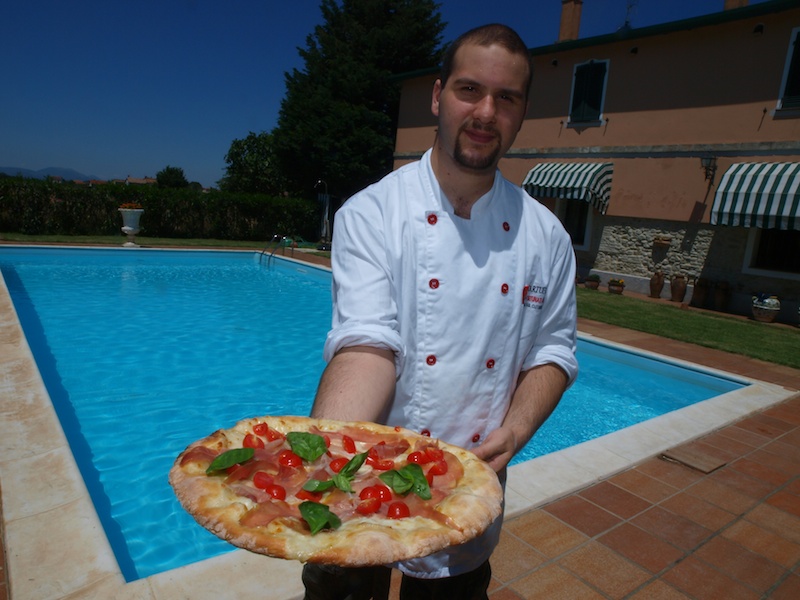



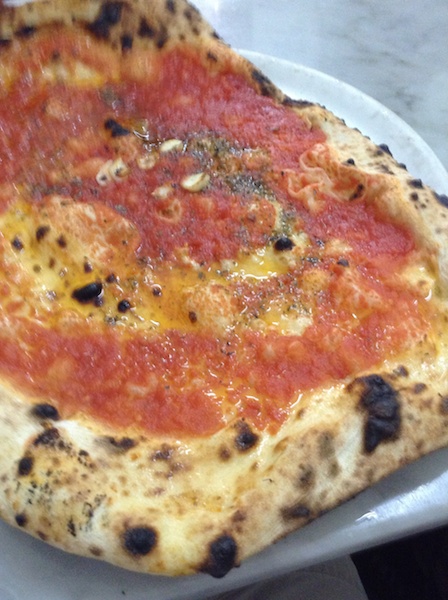
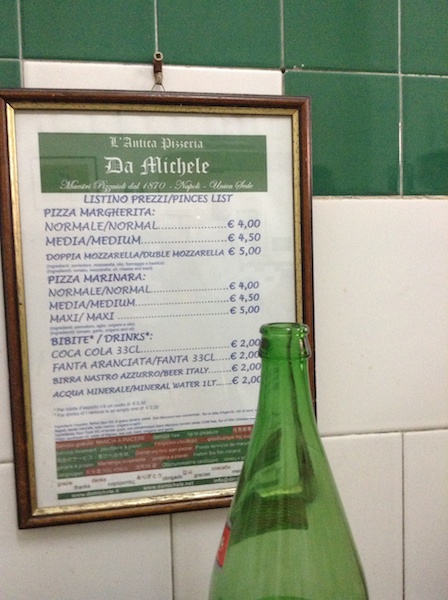
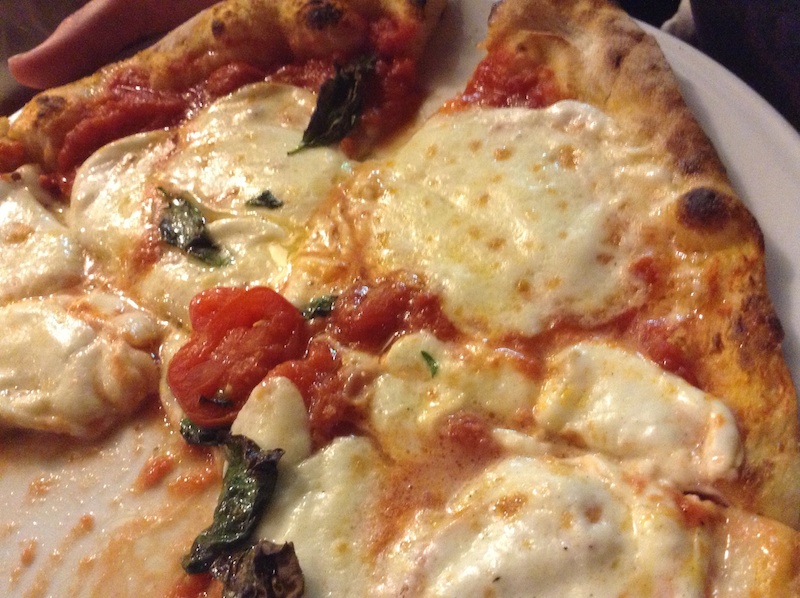
Comments
About The Author
Related Posts
Just sit right back and you'll hear a tale,A tale of a fateful tripThat started…
Home. That's what Cannara has become. Home.Read more »